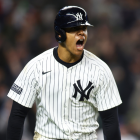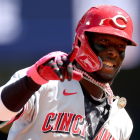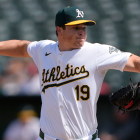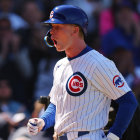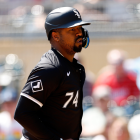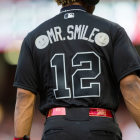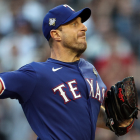 Welcome to this week's edition of Keri The 10! As always, we'll go around the majors with 10 stories that caught our eye from the past seven days. There will be numbers, and occasionally, memes. As always, we will have fun.
Welcome to this week's edition of Keri The 10! As always, we'll go around the majors with 10 stories that caught our eye from the past seven days. There will be numbers, and occasionally, memes. As always, we will have fun.
1. The Rockies are winning; somehow, they're winning with pitching
If you were abducted by aliens six months ago, and your first day back on Earth came Wednesday at Coors Field, you would wonder what happened to the world you used to know. That day, the Rockies beat the defending world champion Cubs, thus winning two out of three in the series. Even more incredible, the Rockies, playing at mile-high altitude against an injury-diminished but still dangerous lineup, put up a goose egg to make it happen.
That 3-0 win typified a very atypical season for the Rockies. It's atypical because they're leading the NL West with a 23-13 record. And it's atypical because they're doing it thanks largely to great run prevention.
Rookie right-hander German Marquez provided much of the heroics Wednesday. The 22-year-old Venezuelan fired six no-hit innings, eventually ending his day with eight shutout frames, with just three hits and one walk allowed, plus eight strikeouts. That continued a wild ride for Marquez, who has given up eight, zero, five and zero runs in his four starts this season. The good news is he has garnered tons of support from his rotation mates. Twenty-two-year-old rookie Antonio Senzatela and 24-year-old rookie Kyle Freeland rank eighth and ninth in ERA among National League starters, a startling development for any pitcher who throws half his games at Coors. Both pitchers are at major risk of regression, both because of their home park and their lackluster strikeout rates, the sixth and eighth lowest in the NL.
Of course, Coors Field is usually such a house of horrors, simply finding pitchers who can offer bulk innings, keep the Rockies in games and avoid the disabled list is a hell of a feat. Even better, the Rockies are winning all these games without nominal staff ace Jon Gray, who's out with a toe injury but could return by month's end if he keeps up his current healing pace. The organization's top pitching prospect, Jeff Hoffman, is making impressive strides at Triple-A Albuquerque (just two homers allowed in six starts) and earning a spot start Thursday against the Dodgers (5 1/3 innings, eight strikeouts) offers another source of potential reinforcements.
For a team that struggles every year just to find live bodies to stand on the mound and take punishment, this kind of pitching depth is both sorely welcome and borderline shocking. Throw in a bullpen that's flourishing with the additions of veteran free agents Greg Holland (20 strikeouts, nine hits, no home runs and a league-leading 15 saves in 16 innings) and Mike Dunn (11 strikeouts in nine innings), and you have the second-best pitching team in the majors, by park-adjusted ERA. Who woulda thunk it?
2. Oakland A's, walk-off masters
On May 6, Adam Rosales struck the winning blow, lacing a two-run single to knock in the winning run in the ninth. On May 7, Ryon Healy was the hero, blasting a homer over the wall in left to win it. Then on May 8, Jed Lowrie completed the trifecta by launching a walk-off homer into the right-field bleachers, the second home run of the game for a hitter not known for his power.
Even with those three straight walk-offs, the A's sit at 16-18, 7 1/2 games behind the front-running Astros. They've dealt with copious pitching injuries this year, and their lineup is loaded with bargain-bin offseason pickups who were largely seen as placeholders until the next generation of Oakland prospects arrives. Still, you think about what a so-so team can do if it's fortunate enough to win a bunch of close games, and you watch an A's team that wasn't expected to do anything start to experience some late-inning magic, and, well ...
You never know.
3. Swing high
Mark Trumbo is off to a slow start, following his MLB-leading 47 homers last year with vastly inferior numbers in every offensive category.
Then on Monday, the Orioles' behemoth slugger reminded us what he could do. Facing Nationals lefty Gio Gonzalez in the first inning, Trumbo got a pitch so high, Nats catcher Matt Wieters nearly had to stand upright as it spun toward the plate. No matter. Trumbo tomahawked at the ball, and crushed it for a home run. It was the highest pitch hit for a home run since tracking pitch locations with accuracy began in 2008.
I have no idea how he did this either.

4. The Nationals bullpen has been a mess
The Nationals might activate both Shawn Kelley and Koda Glover from the disabled list. Bringing those two back-of-the-bullpen relievers back should help the team's beleaguered bullpen. The question is: Will it help enough?
In the time those right-handers have been out, the Nats pen was a nightly roller coaster. Washington added to its total of blown saves (only the disastrous Phillies pen has blown more, among NL teams); when save situations did come back, everyone short of the peanut guy got a shot. Even veteran Matt Albers, The Man Who Would Never Close, notched a save.
The 33-year-old Kelley could be the answer to the closer quandary ... but not if he keeps pitching the way he has this season. Over the past five seasons, Kelley has whiffed nearly 32 percent of the batters he has faced, making him one of the elite strikeout pitchers in the game. But while the strikeouts have persisted this year, he's also serving up meatballs: Nearly two-thirds of the balls hit in play in his 10 innings of 2017 work have been fly balls, and he has already surrendered five homers.
With Kelley doing his best Olive Garden impression, Glover might be the guy who runs with the closer job. The 24-year-old rookie had put up zeroes in five straight appearances before getting touched for two runs at Coors Field on April 25, right before he hit the DL with a hip injury. Even with that outing, Glover's command has been spot on: He walked just one batter over 11 appearances (8 2/3 innings), inducing lots of weak contact and allowing just one extra-base hit in 32 opponent at-bats.
Kelley's two Tommy John surgeries already made manager Dusty Baker reluctant to use him for many back-to-back outings, let alone three in a row. Kelley's gopheritis, combined with both relievers hitting the shelf, might prompt the skipper to shuffle his bullpen pecking order. If one or both pitchers struggle in whatever role they're placed, another scenario could have the Nats rekindle talks for a veteran closer. They acquired Mark Melancon at last year's deadline, then nearly reeled in White Sox stopper David Robertson over the winter; Robertson could be one of several closer candidates who would be trade targets for the Nats if their bullpen doesn't start improving.
Then again, with a loaded starting rotation and a preposterously great offense, maybe they won't even need a ninth-inning white knight at all. As stats ace Ryan Spaeder recently noted, the Nationals as a team are outhitting Miguel Cabrera. That'll make up for a lot of bullpen hiccups.
5. All eyes on Seth Maness
Veteran reliever Seth Maness was set to undergo Tommy John surgery last summer. Given the typical recovery time of a little over a year, that surgery likely would've knocked him out for the 2017 season, meaning we wouldn't see him again until 2018.
Except Maness never had TJ. As St. Louis Post-Dispatch writer Derrick Goold wrote, Maness instead underwent a surgery designed to repair and buttress the existing elbow ligament at the bone, rather than reconstruct the ligament the way Tommy John does. The Royals called Maness up to the majors Wednesday. That means that we could see him pitch in a major-league game as soon as this weekend -- less than nine months after he went under the knife.
In his four big-league seasons, Maness has earned a reputation as a good, if unspectacular reliever. But if he returns as expected, pitches well and stays healthy, he could become one of the most influential medical patients the game has ever known ... possibly the most influential one since Tommy John himself, 43 years ago.
6. Aaron Judge, Eric Thames, Ryan Zimmerman, Mark Reynolds, Yonder Alonso ... please welcome Logan Morrison
In a season that has seen so many different and unlikely slugging heroes, another has quickly and quietly snuck into the league leaderboard for long balls. That someone is Logan Morrison.
Though not quite as punchless as Alonso (who had never even reached double-figure homers in a season), Morrison has been one of the least potent-hitting first basemen in baseball. Since Morrison's rookie season of 2010, he ranks 29th among 34 first basemen in isolated power. This year, everything has changed. Morrison ranks fifth in the American League with nine homers and sixth in isolated power. At 6-feet-2, 240, Morrison has never lacked the size and strength to go yard. So what changed this year? The same thing that has triggered major power upticks for the likes of Alonso, Justin Turner, Josh Donaldson and other sluggers who've seen huge power boosts over the past few years: He abandoned the old Little League notion of hitting down on the ball, and started swinging for the fences.
Morrison's power binge has helped push the Rays into a tie for fourth in AL team home runs through Thursday despite playing in a home park that's one of the least conducive to round trippers.
7. A thousand words
when you get high with your dad pic.twitter.com/haKBHdYDf6
— jg 🍤 (@jacobjbg) May 11, 2017
8. Your NL Central leaders are â¦
...the St. Louis Cardinals. The Cards got off to a horrendous start, hitting a season-worst 3-9 on April 16. Since then they've gone 16-5, including a six-game winning streak that's still going.
The unlikely hero doing much of the damage has been Jedd Gyorko. The 28-year-old infielder has flashed plenty of power in his nearly 2,000 career plate appearances -- he had just never hit for average, and always made too many outs. This season, he has consolidated all those skills. Gyorko ranks sixth in the NL with a .351 batting average, 13th with a .406 on-base percentage and seventh in slugging at .639. Problem is, much of that offensive barrage stems from a .424 batting average on balls in play that's the highest of any NL hitter, some 130 points above league average, and completely unsustainable given historical precedents. With few changes in his batted-ball profile in terms of hard contact or other positive indicators, it's hard to believe this outburst will last much longer.
The good news is that reinforcements are on the way. Dexter Fowler has been relegated to pinch-hitting duty for a week due to shoulder soreness, but he could be back in the lineup as soon as Friday. Meanwhile, Stephen Piscotty could return from his hamstring injury as soon as next week. All three regular Cards outfielders -- Fowler, Piscotty and Randal Grichuk -- have fallen off from their 2016 performance levels. A return to full health for the first two and some positive regression toward the mean for all three could help the league's hottest team pile up more wins, causing chaos in an NL Central division that hasn't played out anywhere near the way everyone expected this season.
9. Alex Wood is on fire
As great as Clayton Kershaw has (predictably) been, the Dodgers need other strong pitching performances to supplement their ace's dominance if they hope to win a fifth straight NL West crown. That pitcher has been left-hander Alex Wood. For more on L.A.'s under-the-radar purveyor of 2017 pitching greatness, we turn to our weekly correspondent Nick Pollack of PitcherList.com.
First, Pollack noted a massive jump in Wood's fastball velocity, from 90.3 to 93.1, one of the biggest such leaps for any pitcher in the league. Wood's two secondary pitches, his knuckle-curve and changeup, have registered gains of about two and two-and-a-half mph. That higher velocity across the board has hiked his whiff rate to a career-high 11.1 percent.
You can see the effects of that velo spike in visual form too. The first pitch is Wood missing over the middle of the plate in a 1-0 count with an 88 mph fastball back in 2015. Kris Bryant makes him pay.
Now here's Wood missing over the heart of the plate this season, behind 2-1 in the count. Jeremy Hazelbaker swings right through Wood's 94 mph fastball, despite its juicy location.
Pollack explained Wood's other major change: "Comparing 2016 and 2017, Wood made a major change in his approach by reducing the numbers of curve balls thrown (29.3 percent to 20.9 percent) in favor of changeups (15 percent to 27.2 percent), and it's working incredibly well. Wood does a fantastic job of keeping his changeup low in the strike zone, which has batters struggling to barrel the ball (13 percent line-drive rate against) and roll over the pitch at a 69.9 percent groundball rate. The result is a poor .028 ISO and .167 batting average allowed on changeups."
Wood's stats pack this season paints the picture of a pitcher who's clicking at an elite level.
His 11.5 K/9 is sixth in the majors among those with at least 20 innings
10th-highest soft contact induced (23.0 percent)
Sixth-highest ground-ball rate (62.2 percent)
Seventh-lowest line-drive rate (13.5 percent)
Third-highest induced infield fly-ball rate (22.2 percent)
1.91 FIP ranks fifth in majors
2.49 xFIP ranks fifth in majors
Has increased his whiff rate three straight years from 8.2 percent in 2015 to 11.1 percent this year
Allowing only 6.7 percent line drives and 80 percent grounders on his knuckle-curve
It took a while for the Dodgers to get the pitcher they were hoping for when they acquired Wood in 2015. In 2017, he has been even better than they could have ever expected.
10. Burning Question of the Week
@jonahkeri Which team's playoff hopes rely the most on the return of their injured SPs? Mets? Mariners? Dodgers? #KeriThe10
— Matt Milkovich (@MattMilkovich) May 11, 2017
Matt offers an opportunity for us to double down on the Dodgers, and on Alex Wood. Los Angeles' plan this season has been to dig maximum value out of all their non-Kershaw starters. The team's actions suggest that the plan involves capping each of those pitchers' innings totals, to keep them fresh throughout the season and also safeguard against potential injuries.
Occasionally, that plan can work a little too well. After Wood posted a 22-to-3 strikeout-to-walk rate in four appearances, the Dodgers saw a chance to give him a more secure spot in the rotation. So they placed Brandon McCarthy on the DL to clear a path. McCarthy had been pitching well in his own right, posting a 3.10 ERA. Also, the condition that landed him on the disabled list was to his non-throwing shoulder, and was merely a minor weightlifting injury. That forced Dodgers manager Dave Roberts to cite the company line: "It's best for all of us."
Look for that pattern to continue all year. Rich Hill has taken longer than expected to return from blister problems, while Kenta Maeda has been awful a year after his impressive MLB debut. So Hyun-Jin Ryu comes off the DL (he got torched in his first start back, but it was in Colorado), and Julio Urias takes up a regular turn in the rotation after having his innings managed for the first month of the season (he has allowed just two runs and nine hits over his first three starts of the year). McCarthy could return next week to take Maeda's spot, setting up a starting five of Kershaw, Wood, Urias, McCarthy and Ryu ... which probably won't last longer than a few weeks, before one of those pitchers lands on the DL, either due to injuries or "injuries."
For as long as baseball has existed, teams have said that you can never have enough pitching. The Dodgers are taking that slogan to extremes this year. They're hoping the end result will be pitching excellence, and a run at their first World Series title in 29 years.
Send a Tweet to @jonahkeri using hashtag #KeriThe10 to submit questions for future No. 10s.














